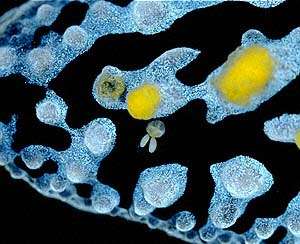
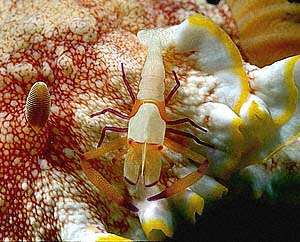
Symbiosis, commensalism, mutualism and parasitism
PHOTO
Upper: A small copepod crustacean (note paired egg sacs) on Phyllidia coelestis, Koumac, New Caledonia, Oct, 1993. Lower: The commensal shrimp Periclimenes imperator on Chromodoris tinctoria, Koumac, New Caledonia, Oct, 1993. Photos: Bill Rudman.
There are many examples in nature of two organisms living in close association with each other. The relationship can consist of two animals, two plants, a plant and an animal, or even a fungus and an algae (such as in lichens). Biologists have tried to give names to and define certain examples of 'living together' such as 'symbiosis' and 'mutualism' and 'parasitism' but it is often difficult to know where one type of association ends and another begins. It is probably better to think of these associations as part of a broad continuum ranging from free-living organisms that depend on others for food, to two organisms that will not survive unless they are always together such as the alga and fungus that combine to form each lichen 'species'.
Here are definitions of a few of the most common words used by biologists to classify such inter-relationships.
• Symbiosis: This comes from a Greek word simply meaning 'living together' and can be used to describe any association between two organisms.
• Mutualism: This can be used to describe an association in which both organisms apparently benefit
• Commensalism: In this association one organism [the commensal] benefits, and the other [the host] is apparently unaffected.
• Parasitism In this association one organism [the parasite] benefits, and the other [the host] is adversely affected [weakened, sickened, damaged etc]. This description would also fit the relationship between a carnivore and its live prey and a herbivore and the plant it feeds on, especially if they are very specialized in the food they eat. We normally define parasites as orgamisms which cannot survive without their host and have special modifications to their body or their life cycle for this association. In many ways though, the difference between a lion eating a gazelle and a flea feeding on a dog, is a matter of relative size.
Many sea slugs have evolved close relationships with other organisms. The simplest associations are the many nudibranchs which are permanently found on, or close by, the organisms they feed on. These in include dorids and their sponges, aeolids on their cnidarians, polycerids on their bryozoans. Here are a few particular examples:
• Commensal crustaceans: The photos at the top of this page show two crustaceans, a copepod and a shrimp, which live in close association with various nudibranchs. They illustarte the many crustaceans which are often found to have close relationships to various sea slugs. In most cases we know nothing about the relationships, but they are generally referred to as 'commensals'. The copepods are small crustacea often found living on dorid nudibranchs. They are easily recognised because their two large egg sacs look like a pair of large 'tails'. Another more spectacular example is the shrimp, Periclimenes imperator, which is always found living on large dorid nudibranchs such as the Spanish Dancer, Hexabranchus, or on chromodorids such as Chromodoris tinctoria.
• Coral feeding nudibranchs: These nudibranchs live their lives on or under the coral colonies they feed on.
• Solar Powered Sea Slugs: Another quite different group of relationships have been discovered with sea slugs which involves plants and plant organelles. One group, the herbivorous sacoglossan sea slugs keep chloroplasts and other plant plastids alive from the plants they eat, and use the sugars they produce from photosynthesis for theis own nutrition. Another group of carnivorous nudibranchs also show various degrees of ability to harness solar power by keeping whole single-celled plants (zooxanthellae) alive in their tissues for the same purpose.
• Gymnodoris nigricolor: Have a look at the page on Gymnodoris nigricolor, a nudibranch which lives with fishes of the Goby family, clinging on to, and apparently eating their fins.
Rudman, W.B., 2004 (July 24) Symbiosis, commensalism, mutualism and parasitism. [In] Sea Slug Forum. Australian Museum, Sydney. Available from http://www.seaslugforum.net/find/symbio
Related messages
Re: Another goby on nudibranch
February 11, 2009
From: Andy Eastwood
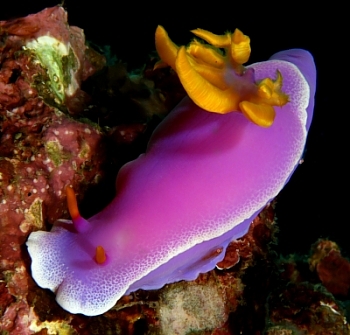
Concerning message #14197:
Here's another one! This one was spotted last off Anilao, Philippines. I ctually didn't see the goby at the time - I only realised it was there when reviewing the photos later!
Andy Eastwood
andrew_eastwood@yahoo.co.uk
Eastwood, A., 2009 (Feb 11) Re: Another goby on nudibranch. [Message in] Sea Slug Forum. Australian Museum, Sydney. Available from http://www.seaslugforum.net/find/22221Dear Andy,
It's four years since Jerry Allen's message so thanks for not forgetting. I don't think we can say that two occurrences on Hypselodoris apolegma is proof of anything but it is certainly interesting and hopefully will be a stimulus for others with sharp eyes to look in the field- or as in your case - to look carefully at your photos
Best wishes,
Bill Rudman
Amphipod crustacean mimic (Southern California)
February 4, 2006
From: Matt Segal
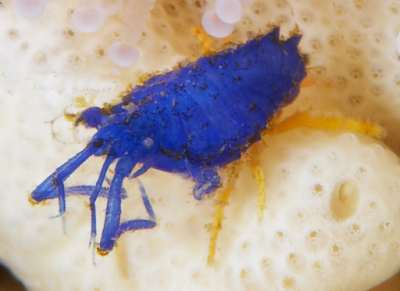
On a recent dive in Southern California (Anacapa Island), I came across the following amphipod crustacean, and after running it by a few people that I know, found that it was a Podocerus cristatus (thank you to Leslie Harris and Don Cadien for the ID).
Locality: Backside of Anacapa Island, California, USA. Depth: 25 ft. Length: 6 mm body, ~10 mm w/ front legs. 28 January 2006. High-surge outcrop. Photographer: Matt Segal
I knew that this species had been linked as a mimic amphipod on this website [message #2641] and [message # 2608], but I am curious as to what nudibranch species this colour form would mimic (notice that its legs are bright yellow in contrast to its body), and what substrate is it supposed to live on?
Thanks in advance.
Matt Segal
mattsegal@carbonos.com
Segal, M.J., 2006 (Feb 4) Amphipod crustacean mimic (Southern California). [Message in] Sea Slug Forum. Australian Museum, Sydney. Available from http://www.seaslugforum.net/find/15713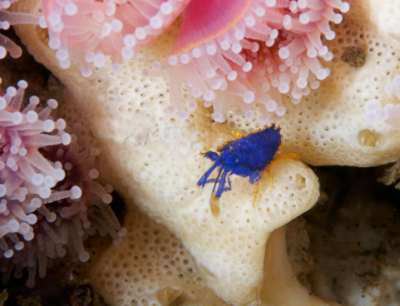
Dear Matt,
I didn't realise this amphipod had so many different colour forms. Just because two animals are very similarly coloured it does not mean they are mimics in the evolutionary sense of the word. Evolutionary mimics are two species - or one species and a model - which have gradually through evolutionary changes grown to look alike. It is possible that lookalikes can also evolve quite by chance. I don't even know if there are any studies to show that the two examples you mention from the Forum are really true mimics. So even if there are blue and yellow animals from California which look extremely similar to this colour form of the amphipod, it does not necessarily follow that one ins mimicking the other.
Best wishes,
Bill Rudman
Ceratosoma with Periclimenes imperator
September 17, 2005
From: Corby James
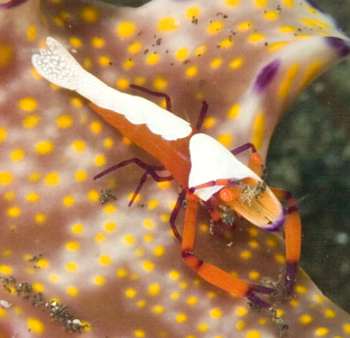
This has been identified by some one as Ceratosoma tenue with Periclimenes imperator and I would like confirmation please.
Locality: Lembeh Straights, N. Sulawesi, Indonesia. Depth: 80 ft. Length: approx. 4-5 cm. 22 August 2005. Sandy bottom covered in soft corals. Photographer: Corby James
Thanks
Corby James
cjames@austin.rr.com
James, C., 2005 (Sep 17) Ceratosoma with Periclimenes imperator. [Message in] Sea Slug Forum. Australian Museum, Sydney. Available from http://www.seaslugforum.net/find/14726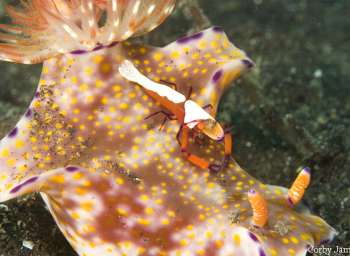
Dear Corby,
The commensal shrimp is correctly identified, but I am not so sure with the Ceratosoma. Ceratosoma tenue has a lobe on each side about halfway between the rhinophores and the large mantle lobe alongside the gills. Ceratosoma gracillimum lacks such a lobe but also lacks any sign of a ridge along each side to mark the mantle edge. I think ther is a ridge in your specimen which would suggest it is C. trilobatum. Usually in C. trilobatum, that ridge is edged with the same colour as the lobe around the head and on each side of the gills, but there are specimens which don't have this colour. It's hard to be sure from your photo, but I am pretty sure it is C. trilobatum.
Best wishes,
Bill Rudman
Commensalism in Californian nudibranchs
July 30, 2005
From: James Lyle & Leslie Harris
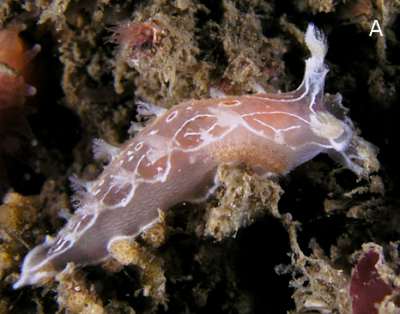
Dear Dr. Rudman:
We have recently observed instances of commensal behavior involving nudibranchs from Southern California. Two of the hitchhikers are juvenile scaleworm polychaetes (family Polynoidae) on Tritona festiva [A, D] and Triopha catalinae [B, C]; the other is a juvenile amphipod Podocerus sp. on Tritona festiva [see message #14299 ].
Locality: Buchannan's Reef, Rancho Palos Verdes. California, USA. Depth: 20 metres. 17 July 2005. rocky reef. Photographer: Jim Lyle
Scaleworms are known for being commensals; some will only attach to a single species while others can live on a variety of other creatures. In Martin & Britayev's 1998 review of all known symbiotic polychaetes (available at http://www.ceab.csic.es/~dani/Colleagues.html ) only two scaleworms are reported on nudibranchs. One is Halosydna brevisetosa on Melibe leonina - that was on this coast - and the other is Hololepidella nigropunctata on Phyllidia varicosa from Hong Kong. So whether this particular association is specific or general it's still fairly novel.
James L. Lyle
Leslie Harris
jlyle@adelphia.net
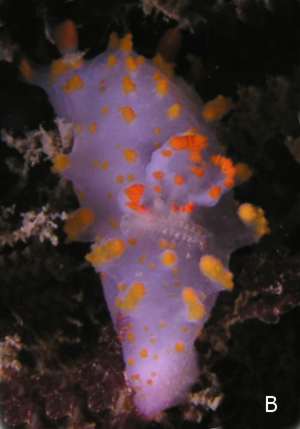
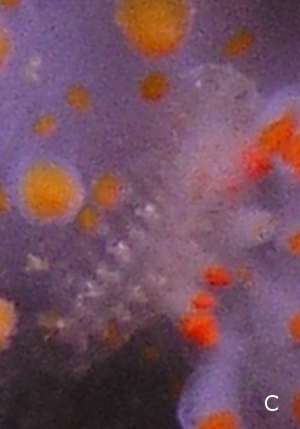
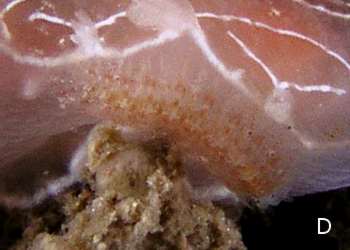
Dear Jim & Leslie,
Thanks for these observations. There is definitely a whole world of associations out there that we have still to explore.
Best wishes,
Bill Rudman
Amphipod commensal on Tritonia festiva
July 30, 2005
From: James Lyle & Leslie Harris
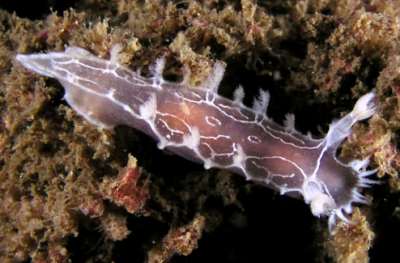
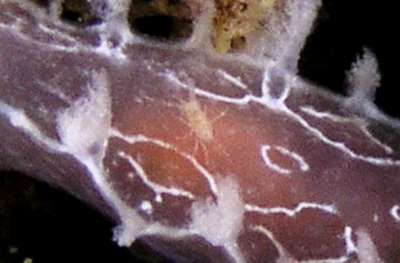
Dear Dr. Rudman:
Two accompany our other message [#14298] on commensal behavior involving nudibranchs from Southern California, here is a record of a juvenile amphipod Podocerus sp. (either P. brasiliensis or P. cristatus, family Podoceridae) on Tritona festiva.
Unlike the scaleworms in the other message, which are known for being commensals, this amphipod was thought to be an accidental passenger by its identifier, Don Cadien.
Locality: Buchannan's Reef, Rancho Palos Verdes, California, USA. Depth: 20 metres. 17 July 2005. rocky reef. Photographer: Jim Lyle
James L. Lyle
Leslie Harris
jlyle@adelphia.net
Lyle, J.L. & Harris, L., 2005 (Jul 30) Amphipod commensal on Tritonia festiva. [Message in] Sea Slug Forum. Australian Museum, Sydney. Available from http://www.seaslugforum.net/find/14299Dear Jim & Leslie,
I guess the only way we will know if there is an association or not is 'constant vigilance'.
Best wishes,
Bill Rudman
Another commensal scaleworm
July 30, 2005
From: James Lyle & Leslie Harris
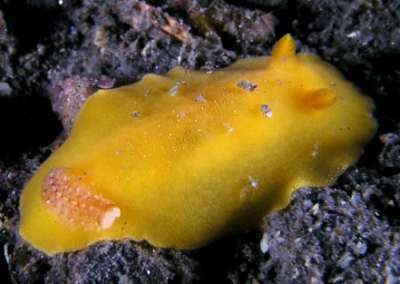
Dr. Rudman,
We've found a third example of a scaleworm riding on a nudibranch (Doriopsilla albopunctata ). The hunt for more is on!
Locality: Redondo Beach, California, USA. Depth: 25 metres. Length of Doriopsilla: 25 mm, 24 July 2005. sand. Photographer: Jim Lyle
Best,
Jim Lyle & Leslie Harris
jlyle@scubadiving.com
Lyle, J.L. & Harris, L., 2005 (Jul 30) Another commensal scaleworm. [Message in] Sea Slug Forum. Australian Museum, Sydney. Available from http://www.seaslugforum.net/find/14447Dear Jim & Leslie,
Good luck! If you keep this up I'll have to start a commensal scale worm page.
Bill Rudman
Re: Another goby on nudibranch
July 11, 2005
From: Bill Rudman
Concerning Jerry Allen's fish on Hypselodoris [message #14197], I have had the following message from Dr Helen Larson, Museum and Art Gallery of the Northern Territory
"looks rather like a teeny tiny baby Pleurosicya that has just settled out ..... Weird!!!"
This is the same genus of gobies suggested by Helen for the earlier fish on Ceratosoma [message #14118]. Any further observations will be very welcome. Mark McGrouther has just added a Fact Sheet on these fish to the Museum's website at: http://www.amonline.net.au/fishes/faq/gobynudi.htm.
Best wishes
Bill Rudman
Another goby on nudibranch
July 5, 2005
From: Jerry Allen
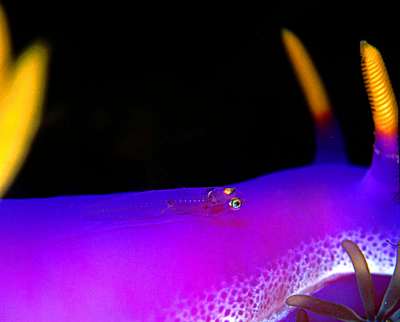
Hello Bill -
Concerning the recent message about a commensal fish on Ceratosoma trilobatum [#14118] from John Weinberg, here is a photo of mine which was recently on Mike Miller's Slug Site of a goby on Hypselodoris apolegma.
This shot was taken last year (July 2004) at 10 m. in the Lembeh Straits close to the Kungkungan Bay Resort, Indonesia. I would love to hear any discussions regarding this goby behaviour. Photo: Jerry Allen.
Best Regards,
Jerry
www.uwshooter.com
uwshooter@aol.com
Allen, J., 2005 (Jul 5) Another goby on nudibranch. [Message in] Sea Slug Forum. Australian Museum, Sydney. Available from http://www.seaslugforum.net/find/14197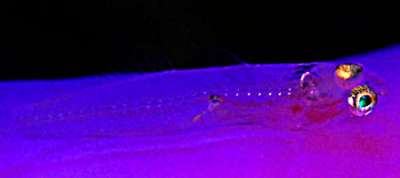
Dear Jerry,
Thanks for the photo. It will certainly be interesting to hear what the fish people have to say about this goby. I realise I might sound a bit desperate to suggest two cases of a transparent goby on a nudibranch is a pattern, but it certainly worth suggesting we all keep out eyes open more more examples
Best wishes,
Bill Rudman
Commensal fish on Ceratosoma trilobatum
June 27, 2005
From: John Weinberg
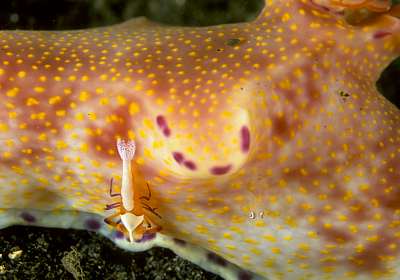
Dear Bill,
I have attached a scan of one of my slides of Ceratosoma trilobatum. After getting my slides processed I noticed that along with the shrimp, Periclimenes imperator, there is also a small fish apparently living happily. It is on the posterior edge of the left lateral lobe, slightly longer than the shrimp in a similar, head down pose. The fish is almost entirely transparent, the eyes being the most visible part, if you 'zoom in' it is possible to make out pectoral fins, the spine and a few bits of organs.It has gone to a lot of 'trouble' not to be noticed. Have you come across this before, and can you kindly tell me what fish it is? Is it commensal, the eyes could be said to match the yellow spots on the slug and it doesn't seem to be 'worried'? by any toxins from C. trilobatum.
Locality: North Sulawesi, Indonesia, Celebes Sea. Depth: 15 m. Length [of Ceratosoma]: 6 inches. June 2004. current swept black sand. Photographer: John Weinberg
Thanks for your help.
Regards
John Weinberg
john@e-scuba.co.uk
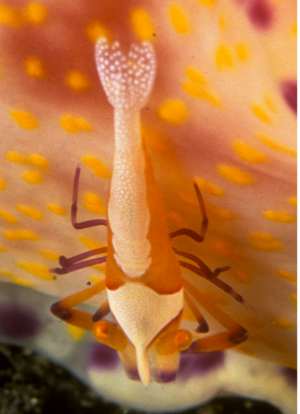
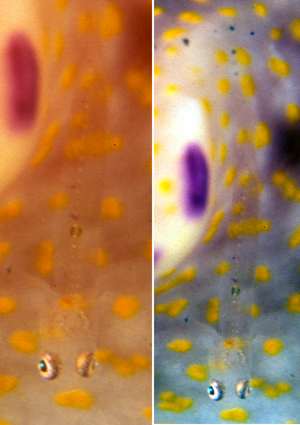
Dear John,
It's amazing what you can find when you look through your photos. I can't say I have noticed a fish like this before, but as you say it does a good job at staying unnoticed. I have included a copy of your photo [lower: far right] where I have altered the colour balnace to show your fish more clearly.
Your fish has caused great excitement amongst my fish colleagues here at the Australian Museum. I showed it to Mark McGrouther, the collection manager, and Doug Hoese, and expert on gobies who suggested it was probably a species of the genus Bryaninops, but suggested we contact Helen Larson, Museum & Art Gallery of the Northern Territory, Darwin, who is an expert on this group. Helen Larson has replied saying:
" - that's neat! I've collected Pleurosicya off holothurians, seapens and Tridacna but never nudibranchs. The fish may be a Pleurosicya, yes, but it has very wide-set eyes like Bryaninops. Mind you it's just a child, so is not easy to identify."
So what we can say is that it is a goby, a family of fish in which many have commensal relationships with other animals. It is also a juvenile, which may mean it will not stay with the nudibranch as it matures, but basically, like so much in the sea, we have a lot to learn. The museum website has an excellent section on fishes at www.amonline.net.au/fishes/index.cfm. Mark McGrouther is planning to include a Fact Sheet on this group. When he does I will add a link.
Best wishes,
Bill Rudman
Chromodoris coi with copepod
March 22, 2004
From: Fredy Brauchli
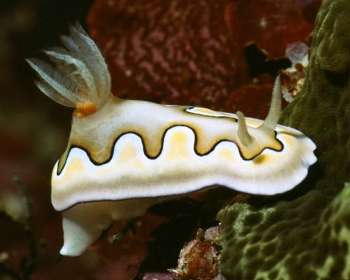
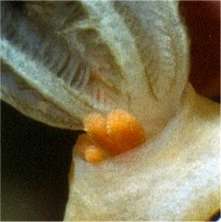
Hi Bill,
Here's a nice record of copepod parasites in the gills Chromodoris coi.
Location: Pandan Island, Occ. Mindoro, Philippines.
Depth: approx. 15 m
Date: late April 2002
Kind regards from Switzerland,
Fredy
brauchli@subaqua.ch
Brauchli, F., 2004 (Mar 22) Chromodoris coi with copepod. [Message in] Sea Slug Forum. Australian Museum, Sydney. Available from http://www.seaslugforum.net/find/12481Thanks Fredy,
Looks like there are at least 2 copepods in the gill pocket, as we can see the tips of at least 2 pairs of egg sacs
Bill Rudman
Mystery mark on Risbecia pulchella
January 25, 2004
From: Stephanie Maleady
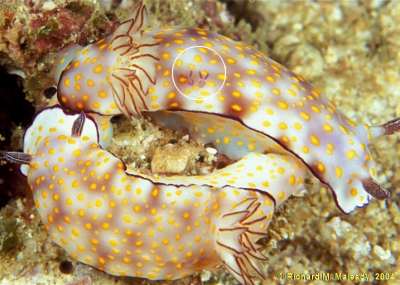
Hi,
My husband and I just returned from Thailand where he photographed this pair of Risbecia pulchella. When he scanned the slide, he noticed some markings on one of the nudibranchs that can only resemble Playboy bunnies. Any idea what these are? At first, we thought it was something in the development of the slide, but these markings show up on all (5) photos that he took, all in the same location on the creature's side.
Photos: Richard A. Maleady
We're very curious.
Any ideas?
Thanks,
Stephanie Maleady
seawasp@earthlink.net
Maleady, S., 2004 (Jan 25) Mystery mark on Risbecia pulchella. [Message in] Sea Slug Forum. Australian Museum, Sydney. Available from http://www.seaslugforum.net/find/11998
Dear Stephanie & Richard,
Your 'Playboy bunnies' are a pair of microscopic crustacea [crabs, lobsters etc] called copepods. Copepods carry a pair of large egg sacs off the back of their body, each sac containing many smll microscopic eggs. They are quite coomon on nudibranchs. See the Symbiosis Page for some more photos of copepdods on various nudibranchs.
Best wishes
Bill Rudman
It's a puzzle
May 10, 2002
From: Mary Jane Adams
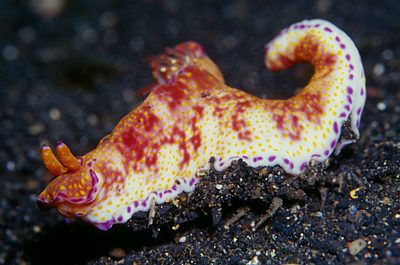
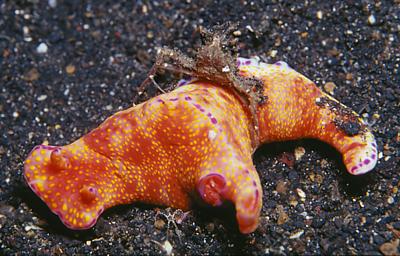
Hi Bill,
Here's a riddle for you: Why did the nudibranch run around backwards with it's tail curled up?
Answer: because it was being carried by a crab. If you look closely at the first picture you can see two little legs under this Ceratosoma trilobatum. I flipped the slug over to get the second picture. After that, the carrying crab scurried underneath again and ran off with the slug standing on it's head. At that point I was laughing so hard I didn't get the picture.
There were a lot of C. trilobatum on this divesite. Many of them had imperial shrimp on them, but this was the only one I saw with a carry crab. I don't think the poor slug was benefitting from this association!
Divesite: Hairball Too, Lembeh Strait, Sulawesi,
Indonesia.
Best regards,
Mary Jane
divepng@yahoo.com
Adams, M J., 2002 (May 10) It's a puzzle. [Message in] Sea Slug Forum. Australian Museum, Sydney. Available from http://www.seaslugforum.net/find/6855Thanks Mary Jane,
As you suggest, this is one confused crab
Bill Rudman
Symbiotic stress
April 10, 2002
From: Ali
Hi bill
i'd just like 2 thank u 4 ur site cause i have 2 do this homework thing and my sci teach is like very strict and takes lots and lots of points of if i dont have this info on commensalism, mutualism, and parasitism. at first this place didn't seem like a place 4 the stuff but hey i guess i thought wrong THANX
~*Ali*~
ICYGIRL25@hotmail.com
Ali, 2002 (Apr 10) Symbiotic stress. [Message in] Sea Slug Forum. Australian Museum, Sydney. Available from http://www.seaslugforum.net/find/6702Dear Ali,
Nice to know we can satisfy a strict science teacher.
Best wishes,
Bill Rudman
Ceratosoma trilobatum with commensal shrimp
September 21, 2001
From: Mary Jane Adams
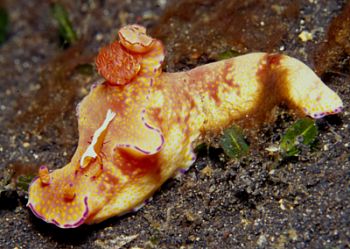
Hi Bill,
Here is another example of commensalism. The shrimp was riding around on the slug like a queen on a royal coach. This Ceratosoma trilobatum with Periclimenes imperator was photographed in Lembeh Straits, Sulawesi, Indonesia, Aug. 13, 2001. Length: about 8 cm, Depth: 5 meters
Best regards,
Mary Jane
divepng@yahoo.com
Adams, M.J., 2001 (Sep 21) Ceratosoma trilobatum with commensal shrimp. [Message in] Sea Slug Forum. Australian Museum, Sydney. Available from http://www.seaslugforum.net/find/5285Thanks Mary Jane,
Periclimenes certainly does look very obvious when it sitting out on its 'host's' back. Whether its own eyesight is good enough to detect danger or whether the defensive glands of the nudibranch are sufficient protection I wouldn't know. It is certainly a relationship which would be worth a look at.
Best wishes,
Bill Rudman
Mutualism and symbiosis
January 24, 2001
From: Lindsay Jennings
Hi. I am doing a report on an ocean ecosystem and I was wondering if you could help me out with some examples of parasitism, mutualism symbiosis?, or something like that?!?! PLEASE HELP ME OUT -- I AM DESPERATE!!!!! hehehaha
thanx a billion!
Lindsay Jennings :)
keeper132000@yahoo.com
Jennings, L., 2001 (Jan 24) Mutualism and symbiosis. [Message in] Sea Slug Forum. Australian Museum, Sydney. Available from http://www.seaslugforum.net/find/3589Dear Lindsay,
The Forum is more than just a help line. Have a look at the GENERAL TOPICS list and you will see entries for Symbiosis and parasitism. You could also use the SEARCH button and find even more references and examples.
Good Luck with your report,
Bill Rudman
Examples of Symbiosis
August 23, 2000
From: Sutha
Hello Bill,
I am high school student from Malaysia. I would like to know more about symbiosis among species around us in more detail cause i have got a project to hand-over. Well i would like to know more about the process and example of those species.
Thank you.
Sutha
v_sutha@hotmail.com
Sutha, 2000 (Aug 23) Examples of Symbiosis. [Message in] Sea Slug Forum. Australian Museum, Sydney. Available from http://www.seaslugforum.net/find/2911Dear Sutha,
I'm afraid I can't discuss symbiosis in great detail but I can give you a few examples found amongst the sea slugs.
There are many examples in nature of two organisms living in close association with each other. Biologists have tried to give names to and define certain examples of 'living together' such as 'symbiosis' and 'mutualism' and 'parasitism' but it is often difficult to know where one type of association ends and another begins. It is probably better to think of these associations as part of a broad continuum ranging from free-living organism that depend on others for food, to two organisms that will not survive unless they are always together such as the algal and fungal components of lichens.
But before I get too complicated, there are a number of very good examples of what we generally call 'symbiosis' found amongst the opisthobranchs.
• Some herbivorous sacoglossan sea slugs, are able to keep the chloroplasts from the algae they eat alive and functional in their bodies, where they photosynthesise, producing sugars and other carbohydrates which the slugs can use for their own nutrition.
• Some aeolid nudibranchs feed on sea anemones and soft corals which have symbiotic one-celled plants [zooxanthellae] in their bodies. The aeolids 'steal' these zooxanthellae and keep them alive in their own bodies much like the sacoglossans.
If you have a look at the page on Solar Powered Sea Slugs you will find information on these animals and links to other pages with more information.
• If you look at the photos at the top of this page you will see two crustacea which are often found living on sea slugs.
• Have a look at the page on Gymnodoris nigricolor which lives with fishes of the Goby family, clinging on to, and apparently eaten their fins.
Also have a look at the messages below yours on this page. You will find more information and discussion on symbiosis there.
I hope this will help you,
Good luck with your project,
Bill Rudman.
Commensalistic Symbiosis
March 24, 2000
From: Josh Williamsen
Dear Bill,
I am a first year natural resource technology student. I have been asked to write up a small section on any of the three types of symbiosis . I would like to know if you could give me one or two examples of commensalistic symbiosis (where one member of the partnership benefits and the other is indifferent).
thanks
josh
Lithium_79@hotmail.com
Williamsen, J., 2000 (Mar 24) Commensalistic Symbiosis. [Message in] Sea Slug Forum. Australian Museum, Sydney. Available from http://www.seaslugforum.net/find/2141Dear Josh,
It is quite hard to put every animal-animal, plant-animal, plant-plant relationship into a system invented by humans. For one thing, each relationship is probably slightly different and for another there are probably examples which straddle some of the boundaries between different 'states'.
Have a look at the two examples at the top of the Symbiosis Page, which I think meet your criteria, and read some of the messages below. Also have a look at the Solar-powered Sea Slugs Page. I am not sure whether the relationship between single-celled plants and the nudibranchs fits your category or not. I don't think we know yet whether the zooxanthellae can survive as free-living plants.
Hope this of some help,
Best wishes,
Bill Rudman.
Examples of endoecism
December 9, 1999
From: Sonia
Dear Bill,
I was wondering if you could give me a couple of examples that exhibit endoecism. Endoecism is a partnership in which one animal habitually shelters within the burrow or tube of another - shelter or protection is the dominate factor.
Thank you,
Sonia.
sonia1@gwu.edu
Dear Sonia,
I'm afraid sea slugs don't live in burrows so they are not a good group to look for examples of endoecism.
Best wishes,
Bill Rudman.
Nudibranch with commensal shrimp
November 14, 1999
From: Erik Schloegl
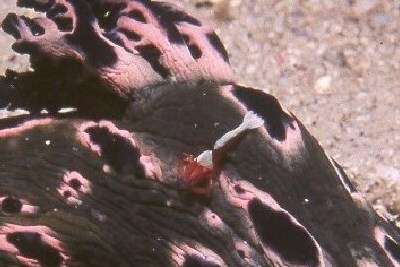
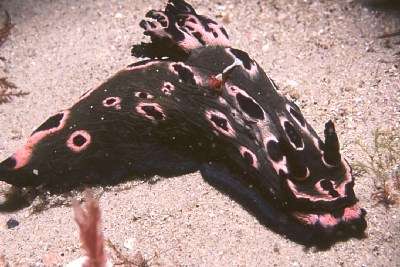
Dear Bill,
Here's a photo taken at Cabbage Tree Island, off Port Stephens, NSW, at Easter, 1999. Depth: 8m. Sandy Bottom. It's a rather large specimen, close to 10cm, with - as you can see - a commensal shrimp living on it. The pink colour is actually fluorescent (if that's the right word) in the sense that it appears a very bright red to the diver's eye under natural light. When I got the slide developed I was actually quite disappointed how drab it looked. I haven't been able to find the species in any book; my amateur guess would be that it's some Nembrotha or Tambja.
Best regards,
Erik Schloegl
schloegl@maths.uts.edu.au
Dear Erik,
I'm pretty sure the shrimp is Periclimenes imperator which is a common commensal of nudibranchs and some sea cucumbers. It is often found with Hexabranchus sanguineus. Over 200 species of the pontoniine shrimps have been reported from the Indo-West Pacific. All seem to have a commensal relationship with other animals ranging from sea anemones and starfish to sea slugs.
The nudibranch it is on is indeed a species of Nembrotha, which is at present unnamed.
Best wishes,
Bill Rudman.
Slugs and Microbes
June 5, 1999
From: Daniel Vega Mendoza
Hi,
I am Daniel ,
I am interested in the diverse ways that microorganisms interact (commensalism, synergism, symbiosis etc) especially those related to human health and the production of secondary metabolites.
Email me
Thanks
Daniel Vega Mendoza
Peru
dvega_mendoza@hotmail.com
Mendoza, D.V., 1999 (Jun 5) Slugs and Microbes. [Message in] Sea Slug Forum. Australian Museum, Sydney. Available from http://www.seaslugforum.net/find/895Dear Daniel,
I am not sure if you are interested in interactions between different micro-organisms or between micro-organisms and other animals such as Sea Slugs. I am not an expert on micro-organisms so I can't really help in the first area. If you are interested in the second area then I guess there are a number of pages in the Forum which may interest you.
Have a look at 'Solar-powered' Sea Slugs for information on nudibranchs with symbiotic relationships with unicellular zooxanthellae, and sacoglossans that retain living organelles, such as plant plastids, in their tissues.
Have a look at the pages which describe the specialised cnidosacs, at the tip of aeolid cerata. The cnidosacs contain nematocyts, which are stinging organelles removed intact and functional from cnidarians.
Another area of interest are the defensive chemicals retained by many Sea Slugs from their food. These are often secondary metabolites. Have a look at Sea Slug Defence page and in particular the page on Chemical Defence which is a list of relevant publications.
Also have a look at the top of this page, which is a general page on symbiosis and commensalism. I hope this is of some use to you,
Best wishes,
Bill Rudman.
Information about commensalism
February 20, 1999
From: Kara Hailey
I am doing a research project for my Biology of fishes class. I was wondering if you could possibly give me some information on the Genus and species names of fish or other marine animals that are involved in commensalism.
I am a Marine Biology major at the College of Charleston.
kshailey@edisto.cofc.edu
Hailey, K., 1999 (Feb 20) Information about commensalism. [Message in] Sea Slug Forum. Australian Museum, Sydney. Available from http://www.seaslugforum.net/find/592Dear Kara,
This is a Sea Slug Site rather than a fish site. However if you go to the GENERAL TOPICS index you will find two pages which discuss Symbiosis and Commensalism. By chance, one of the pages has a link to Bob Bolland's Okinawa Slug Site where he has a set of pictures of nudibranch which appears to live commensally with a few species of fish (gobies).
You will find more messages about commensals below your message on this page.
Best wishes,
Bill Rudman.
Commensalism
January 18, 1999
From: Kerry
I enjoyed your website but unfortunatly I did not gather all the information I needed for a report I am writing on commensalism symbiosis. I am looking for specific commensalism relationships that occur in the ocean biome. If you know of any links that would be useful to me, please email me.
Thanks!
Kerry.
ker_ker_ker@hotmail.com
Dear Kerry,
I guess you've looked at the information at the top of this Symbiosis and Commensalism page and the attached messages. I'm afraid I don't know of any easy way to get more information off the web. There is no specific "Commensalism" website, to my knowledge, but you can find some examples if you do a global search for "commensal" or "commensalism". As I have said before, there are still some things which are best found by going to a good library and having a browse. Most good biology text books have examples of commensals, as do marine biology books.
Good luck with your report,
Bill Rudman.
Parasite and Mutualistic relationships
November 21, 1998
From: Tammy Pearson
I am in my fourth year of university and i am searching for an interesting topic for a research paper. The topic is about mutualistic and parasitic relationship between three different kingdoms. ie a animal, plant and say a fungi. What I am having trouble with is finding information on interesting organisms that show these relationships. So essentially any ideas would be great.
Tammy Pearson
Alberta, Canada
peartj00@uleth.ca
Pearson, T., 1998 (Nov 21) Parasite and Mutualistic relationships. [Message in] Sea Slug Forum. Australian Museum, Sydney. Available from http://www.seaslugforum.net/find/326dear Tammy,
Perhaps someone will have a brilliant idea. An animal eating a lichen (algae + fungus) would probably fit the specifications but so would a human, dressed in cotton clothes who liked eating mushrooms!
Most animals have a huge skin and gut fauna of protozoa and bacteria. In reality I would think every animal would fit your description.
Concerning the opisthobranch examples described in the Forum. I don't think they fit your specifications, although there are interesting thoughts that plant plastids are in fact obligate parasite or commensal protozoa in plants.
Bill Rudman.
Rudman, W.B., 1998 (Nov 21). Comment on Parasite and Mutualistic relationships by Tammy Pearson. [Message in] Sea Slug Forum. Australian Museum, Sydney. Available from http://www.seaslugforum.net/find/326"Commensalistic symbiosis"
October 30, 1998
From: Laura
Can you send me some examples of commensalistic symbiosis please?
Laura
Dear Laura,
Have a look through this "Symbiosis and commensalism" page. There are pictures at the top and answers to some other questions below.
Just a general point, I would like the Sea Slug Forum to be a two way street. I don't mind answering questions but it is nice to have some idea who is asking, why they are interested etc. It is also interesting to other participants in the Forum.
If I have some idea of why you are asking the question, and at what educational level you are at, it helps me to give an appropriate answer.
If I get some feedback, or background information, it makes me feel less like an anonymous machine regurgitating answers to anonymous questions.
Basically it would be nice to know where you are from, why you are interested or whether you are 6 or 60. And I'm afraid your email address didn't come through either, so I can't let you know this message has been posted.
Hope to hear from you,
Bill Rudman
symbiosis
October 25, 1998
From: unidentified enquirer
what are some types of plant/plant and animal/plant symbiotic relationships?
thank you
dcunited6@yahoo.com
There are some examples of symbiosis involving sea slugs at the top of this page (Symbiosis & commensalism) and at Solar-powered sea slugs here in the Sea Slug Forum.
Unfortunately, as much as I would like to, I haven't the time to answer broad ranging questions on all aspects of biology. One advantage of the internet is how easy it is to search for specialised information. If you use the SEARCH button at the top of this page and choose a Search engine such as Alta Vista, and type in symbiosis, you will find many useful pages to look at. There are a lot of useless pages as well .. businesses called "Symbiosis" etc, but you will soon find how to cull these out.
Good luck in your searching.
Bill Rudman
Symbiosis and commensalism
March 28, 1998
From:
Dear sir,
In addition to learning more about the mucus on sea slugs' bodies, I would like to know about any symbiotic relationships that sea slugs share with any other organisms.
Thank you for your time,
Andrea Stephenson
Moulton, Texas,
USA
"Symbiosis" and "commensalism" are two of many names that have been given to pairs of organisms that live together in a close relationship. The relationship can consist of two animals, two plants, a plant and an animal, or even a fungus and an algae (such as in lichens). Many sea slugs have developed such relationships. Small crustacea called copepods are often found living on dorid nudibranchs. They have not been studied well enough to know whether each nudibranch has its own species of copepod or whether the copepods live exclusively on the nudibranchs. The copepods are easily recognised because their two large egg sacs look like a pair of large "tails". Another more spectacular example is the shrimp Periclimenes imperator which is always found living on large dorid nudibranchs such as the Spanish Dancer, Hexabranchus, or on chromodorids such as Chromodoris tinctoria.
Bob Bolland has just posted a series of photos of another remarkable association, this time between a nudibranch (Gymnodoris nigricolor and fish (gobies). It is well worth a look.
Another quite different group of relationships have been discovered with sea slugs and involves plants and plant organelles. As I have described for Elysia pilosa many sacoglossans keep chloroplasts and other plant plastids alive to obtain the sugars they produce from photosynthesis. Some nudibranchs show various degrees of ability to harness solar power by keeping whole single-celled plants (zooxanthellae) alive in their tissues for the same purpose. This is described on the page on "solar-powered nudibranchs"
Bill Rudman
Rudman, W.B., 1998 (Mar 28). Comment on Symbiosis and commensalism by . [Message in] Sea Slug Forum. Australian Museum, Sydney. Available from http://www.seaslugforum.net/find/135